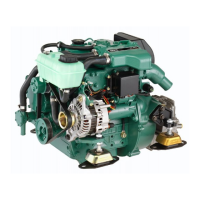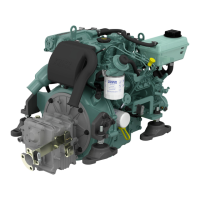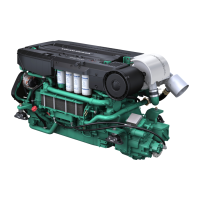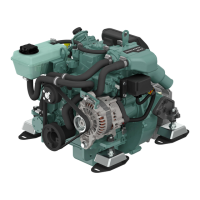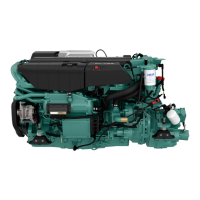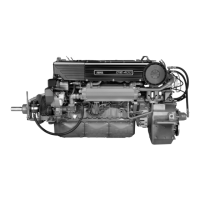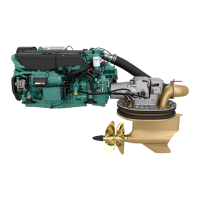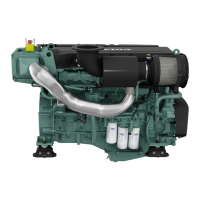Do you have a question about the Volvo Penta D1-30 and is the answer not in the manual?
Congratulates the owner on their new Volvo Penta marine engine.
Discusses harmful chemicals used in marine engines and workshop practices for safe handling.
Warns about fire and explosion risks from fuels, lubricants, and battery gases, emphasizing prevention.
Mandates operating engines in well-ventilated areas or with exhaust ventilation to remove hazardous gases.
Warns about the dangers of approaching a running engine's rotating parts and hot surfaces, advising caution.
Warns to close sea cocks before working on the cooling system below the waterline to prevent water entry.
Highlights risks of fire and explosion during refueling; engine must be stopped and no smoking.
Warns about fire and explosion risks near batteries; avoid sparks and open flames during handling.
Explains the purpose of the manual and advises keeping it available for future reference and safe operation.
Details the limited warranty coverage for Volvo Penta marine engines and outlines owner responsibilities for validity.
Explains the engine break-in period, proper operation, and the importance of monitoring oil levels.
Details the functions of the On/Off, Start, Multi-function, and Stop buttons for engine control.
Describes various gauges like the tachometer and their functions, and explains operating information symbols.
Explains the EVC system display, its screens, configuration options, and how to adjust contrast.
Describes the single-lever control for gearshift and throttle functions and how to maneuver the boat.
Lists essential checks like oil, coolant, and fuel levels before starting the engine.
Details the steps to start the engine using the control panel and the on/off and start buttons.
Advises reading instruments and alarm displays immediately after start and regularly during operation for monitoring.
Explains how to respond to engine alarms, including reducing speed, canceling the alarm, and taking necessary actions.
Details how to shift between ahead and astern at idle to prevent stress on the transmission and engine stalling.
Details the steps to properly shut down the engine using the stop button and on/off button.
Outlines draining the seawater system and ensuring sufficient antifreeze for cold weather to prevent freeze damage.
Explains the coolant temperature lamp and necessary checks for overheating issues.
Describes the oil pressure lamp and necessary checks for low oil pressure issues.
Explains the "system fault" symbol indicating short circuits, cable breaks, or auxiliary failures.
Provides a table of symptoms and possible causes for engine malfunctions, with cross-references to solutions.
Details the procedure for safely connecting and using auxiliary batteries to start the engine.
Lists service types (A-F) and their recommended intervals based on operating hours or calendar time.
Advises regular visual checks of the engine and engine bay before and after operations for abnormalities.
Explains how to check, adjust, and replace drive belts to ensure proper tension and condition.
Guides on how to correctly check and top up the engine oil level, emphasizing not overfilling.
Details the step-by-step procedure for replacing the engine fuel filter, including purging the system.
Guides on inspecting the raw water pump impeller for damage and replacing it if necessary.
Details checking and cleaning the seawater filter to prevent blockages and engine overheating.
Covers battery safety, handling, and maintenance recommendations for increasing service life and avoiding accidents.
Details the steps for safely disconnecting and connecting batteries during replacement, emphasizing correct polarity.
Warns about incorrect electrical installations causing leakage current and inadequate galvanic protection.
Provides instructions for checking and topping up the oil level in the reverse gear.
Explains how to change the oil in the reverse gear, including draining and refilling.
Guides on checking and topping up the transmission lubricant level, emphasizing not overfilling.
Explains regular checks of sacrificial anodes on the drive and their replacement when corroded.
Explains the annual cleaning and greasing of the propeller, including blade cog and bearing surfaces.
Details the steps for removing propeller blades, nuts, and the propeller hub for maintenance.
Lists essential tasks for preparing the boat and engine for winter storage, ensuring proper conservation.
Details the steps for preparing the boat and engine after storage, including checks and installations for next season.
Presents technical specifications for different engine models, including power, displacement, and dimensions.
Details general and special requirements for diesel fuel quality, including standards, additives, and cold-flow properties.
Provides data on coolant capacity, thermostat opening temperatures, and system volumes for different engines.
Details system voltage, battery capacity, alternator, and starter motor specifications.
Explains the importance of identification numbers for service and ordering spare parts.
States conformity with exhaust emission requirements and other essential standards for specific engine models.
Congratulates the owner on their new Volvo Penta marine engine.
Discusses harmful chemicals used in marine engines and workshop practices for safe handling.
Warns about fire and explosion risks from fuels, lubricants, and battery gases, emphasizing prevention.
Mandates operating engines in well-ventilated areas or with exhaust ventilation to remove hazardous gases.
Warns about the dangers of approaching a running engine's rotating parts and hot surfaces, advising caution.
Warns to close sea cocks before working on the cooling system below the waterline to prevent water entry.
Highlights risks of fire and explosion during refueling; engine must be stopped and no smoking.
Warns about fire and explosion risks near batteries; avoid sparks and open flames during handling.
Explains the purpose of the manual and advises keeping it available for future reference and safe operation.
Details the limited warranty coverage for Volvo Penta marine engines and outlines owner responsibilities for validity.
Explains the engine break-in period, proper operation, and the importance of monitoring oil levels.
Details the functions of the On/Off, Start, Multi-function, and Stop buttons for engine control.
Describes various gauges like the tachometer and their functions, and explains operating information symbols.
Explains the EVC system display, its screens, configuration options, and how to adjust contrast.
Describes the single-lever control for gearshift and throttle functions and how to maneuver the boat.
Lists essential checks like oil, coolant, and fuel levels before starting the engine.
Details the steps to start the engine using the control panel and the on/off and start buttons.
Advises reading instruments and alarm displays immediately after start and regularly during operation for monitoring.
Explains how to respond to engine alarms, including reducing speed, canceling the alarm, and taking necessary actions.
Details how to shift between ahead and astern at idle to prevent stress on the transmission and engine stalling.
Details the steps to properly shut down the engine using the stop button and on/off button.
Outlines draining the seawater system and ensuring sufficient antifreeze for cold weather to prevent freeze damage.
Explains the coolant temperature lamp and necessary checks for overheating issues.
Describes the oil pressure lamp and necessary checks for low oil pressure issues.
Explains the "system fault" symbol indicating short circuits, cable breaks, or auxiliary failures.
Provides a table of symptoms and possible causes for engine malfunctions, with cross-references to solutions.
Details the procedure for safely connecting and using auxiliary batteries to start the engine.
Lists service types (A-F) and their recommended intervals based on operating hours or calendar time.
Advises regular visual checks of the engine and engine bay before and after operations for abnormalities.
Explains how to check, adjust, and replace drive belts to ensure proper tension and condition.
Guides on how to correctly check and top up the engine oil level, emphasizing not overfilling.
Details the step-by-step procedure for replacing the engine fuel filter, including purging the system.
Guides on inspecting the raw water pump impeller for damage and replacing it if necessary.
Details checking and cleaning the seawater filter to prevent blockages and engine overheating.
Covers battery safety, handling, and maintenance recommendations for increasing service life and avoiding accidents.
Details the steps for safely disconnecting and connecting batteries during replacement, emphasizing correct polarity.
Warns about incorrect electrical installations causing leakage current and inadequate galvanic protection.
Provides instructions for checking and topping up the oil level in the reverse gear.
Explains how to change the oil in the reverse gear, including draining and refilling.
Guides on checking and topping up the transmission lubricant level, emphasizing not overfilling.
Explains regular checks of sacrificial anodes on the drive and their replacement when corroded.
Explains the annual cleaning and greasing of the propeller, including blade cog and bearing surfaces.
Details the steps for removing propeller blades, nuts, and the propeller hub for maintenance.
Lists essential tasks for preparing the boat and engine for winter storage, ensuring proper conservation.
Details the steps for preparing the boat and engine after storage, including checks and installations for next season.
Presents technical specifications for different engine models, including power, displacement, and dimensions.
Details general and special requirements for diesel fuel quality, including standards, additives, and cold-flow properties.
Provides data on coolant capacity, thermostat opening temperatures, and system volumes for different engines.
Details system voltage, battery capacity, alternator, and starter motor specifications.
Explains the importance of identification numbers for service and ordering spare parts.
States conformity with exhaust emission requirements and other essential standards for specific engine models.
| Engine Type | Diesel |
|---|---|
| Number of Cylinders | 3 |
| Alternator | 115A |
| Fuel System | Direct injection |
| Compression Ratio | 23:1 |
| Type | Marine engine |
